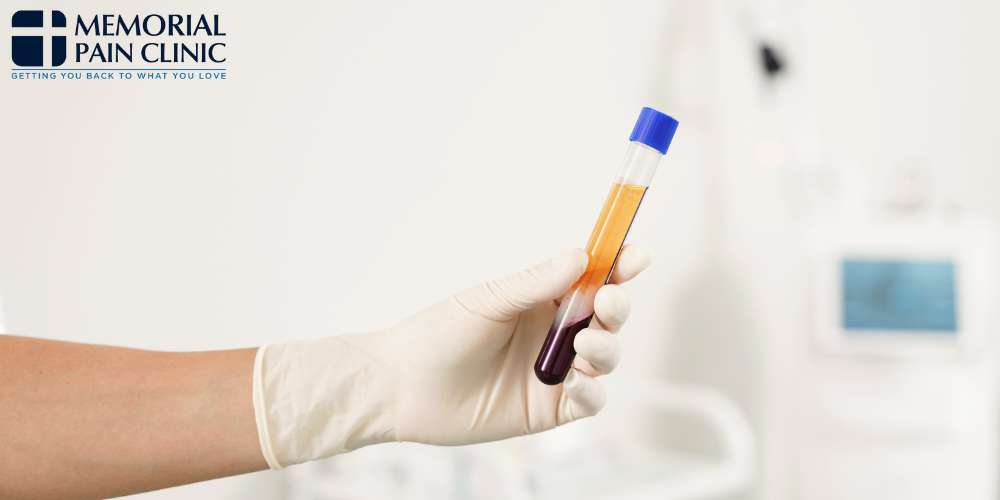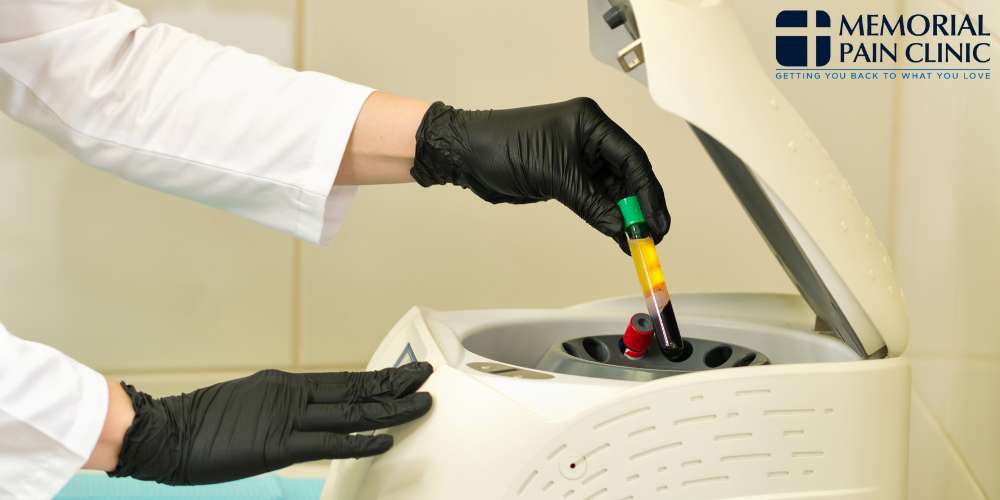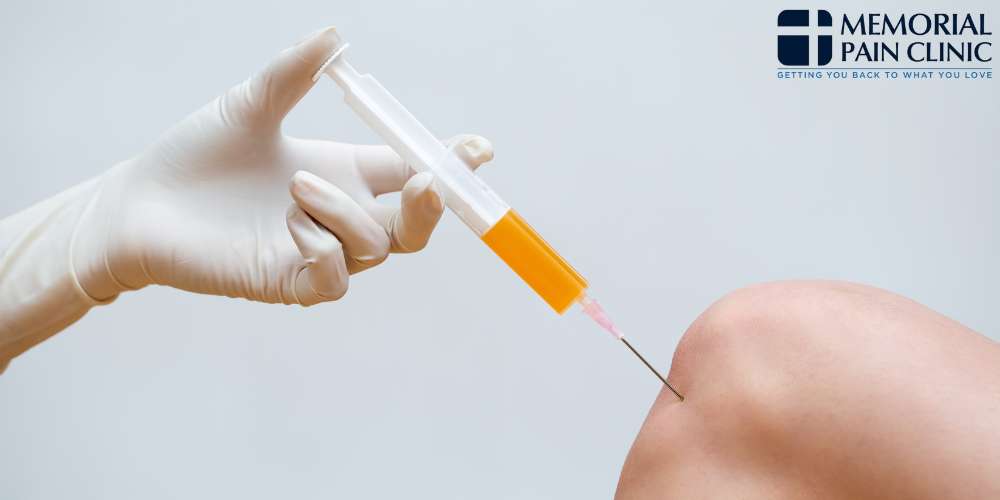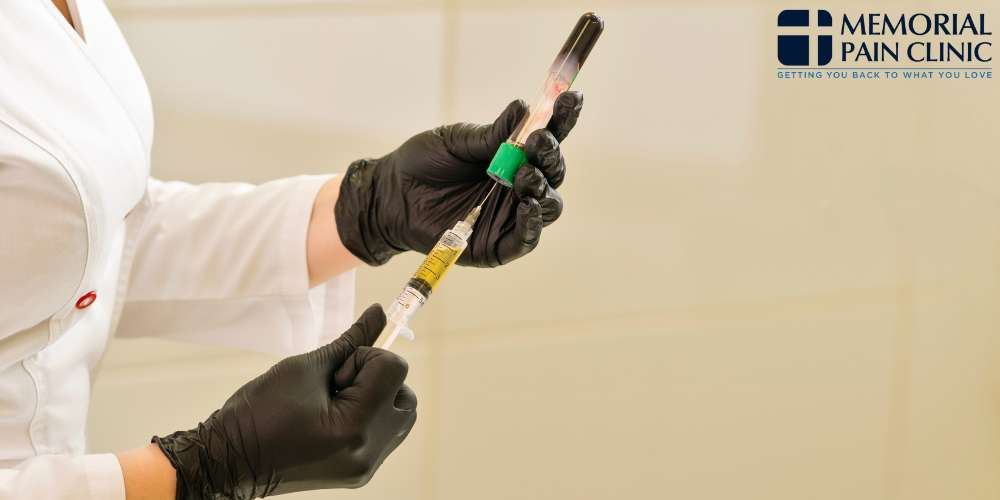Platelet-Rich Plasma (PRP) Injection Tulsa, OK
Our Services

Are you exploring innovative solutions for chronic pain relief in Tulsa, OK? At Memorial Pain Clinic, we specialize in advanced pain management techniques, including Platelet-Rich Plasma (PRP) injections. PRP therapy harnesses the healing power of your own blood to accelerate tissue repair, reduce inflammation, and alleviate pain.
Whether you’re dealing with joint pain, tendon injuries, or osteoarthritis, our experienced team is dedicated to providing personalized, minimally invasive treatments to help you regain your quality of life. To schedule an appointment with us about a PRP injection, please call our office at 918-200-9944 today.
What Are Platelet-Rich Plasma Injections?

PRP stands for Platelet-Rich Plasma, and PRP injections involve injecting a concentration of a patient’s own platelets into an injured area to promote healing and reduce pain. Platelets are a type of blood cell that contains growth factors and other proteins essential for tissue repair and regeneration.
The process of PRP injection typically involves the following steps:
- Blood Collection: A small amount of the patient’s own blood is drawn, usually from the arm, similar to a routine blood test.
- Centrifugation: The collected blood is then processed in a centrifuge machine to separate the platelets from other blood components, such as red blood cells and plasma. This results in a concentrated solution of platelet-rich plasma. Platelets help the blood clot in the body.
- Injection: The platelet-rich plasma is then injected into the injured or affected area, such as a joint, tendon, ligament, or muscle, under ultrasound or fluoroscopic guidance to ensure precise placement.
What Does Plasma Do for Your Body?
PRP injections are thought to stimulate the body’s natural healing processes by delivering a high concentration of growth factors, white blood cells, and cytokines to the site of injury. These growth factors can promote tissue regeneration, reduce inflammation, and accelerate healing.
PRP Benefits
Platelet-rich plasma injections have many benefits, including the following.
- Enhanced healing
- Reduced pain
- Minimally invasive procedure
- Low risk of allergic reactions
- Improved joint function
- Reduced inflammation
- Minimal downtime
PRP Injection Side Effects
While the side effects of PRP treatments are rare, it’s important for patients to understand the potential risks and side effects before undergoing treatment. The potential side effects of these treatments include the following.
- Pain at the injection site
- Swelling
- Bruising
- Infection
- Allergic reaction
- Tissue damage
- Nerve injury
- Temporary increase in pain
- Blood clotting issues
What Is PRP Treatment Used For?

PRP (Platelet-Rich Plasma) treatment is used for a variety of medical and aesthetic purposes. Some common uses of PRP treatment include:
- Orthopedic conditions, such as tendon, ligament, muscle, and joint injuries
- Sports injuries
- Soft tissue injuries
- Osteoarthritis
- Muscle injuries
- Dermatological conditions
- Chronic wounds or post-surgical healing
- Dental procedures
- Cosmetic procedures
While PRP treatment has shown promise in various medical and aesthetic applications, the evidence supporting its effectiveness may vary depending on the specific condition being treated. It’s essential to consult with a qualified healthcare provider or specialist to determine if PRP therapy is an appropriate option for your individual needs and goals.
PRP Knee Injection
A PRP knee injection is a medical treatment where platelet-rich plasma (PRP) derived from a patient’s own blood is injected into the knee joint to promote healing and reduce pain. The procedure involves drawing a small amount of the patient’s blood, processing it to concentrate the platelets, and then injecting the PRP directly into the knee.
This treatment is often used for conditions such as knee osteoarthritis, tendon injuries, and ligament sprains, aiming to accelerate tissue repair, reduce inflammation, and improve joint function.
PRP Injection Recovery Time
The recovery time after a PRP injection varies depending on the individual and the condition being treated, but generally, patients can expect to experience some initial soreness and mild swelling at the injection site for a few days. Most patients are able to resume light activities within a day or two, while more strenuous activities or physical therapy may be recommended to be postponed for about a week.
Full recovery and noticeable improvement in symptoms typically occur within a few weeks, although it can take up to several months for the full benefits of the PRP treatment to be realized. PRP injections should help speed up the body’s natural healing process, so recovery times are usually very short compared to other, more invasive treatment options.
How Long Should You Rest After PRP Injections?
After a platelet-rich plasma injection, we generally recommend resting the treated area for a period of 24 to 48 hours to allow the initial healing process to begin. This allows for blood clots and general healing as the injections start to work.
Does PRP Work?

Platelet-rich plasma (PRP) injections have shown promising results for various conditions, particularly in promoting tissue healing and reducing pain. Research and clinical evidence suggest that PRP can be effective in treating joint pain, tendon injuries, osteoarthritis, and certain sports injuries by harnessing the body’s natural healing processes through the concentrated growth factors and proteins in the plasma. Generally, PRP injections work well because they release growth factors and promote healing in the body.
How Long Do PRP Injections Last?
The duration of the effects of PRP injections can vary widely depending on the condition being treated, the severity of the condition, and the individual’s response to the treatment. Generally, patients may start to notice improvement within a few weeks after the injection, with peak benefits often occurring around three to six months post-treatment. The relief and functional improvements can last anywhere from six months to a year or more, although some patients may require multiple injections to maintain the benefits.
Contact Memorial Pain Clinic for PRP Injections in Tulsa, OK
If you’re considering PRP injections as a solution for managing pain and promoting healing, Memorial Pain Clinic in Tulsa, OK, is here to help. Our expert team is committed to delivering personalized care and the latest in pain management treatments to ensure you achieve the best possible outcomes.
Don’t let chronic pain control your life—take the first step towards relief and improved well-being by contacting us today. Schedule a consultation to learn more about how PRP injections can benefit you and to develop a tailored treatment plan designed to meet your unique needs.
